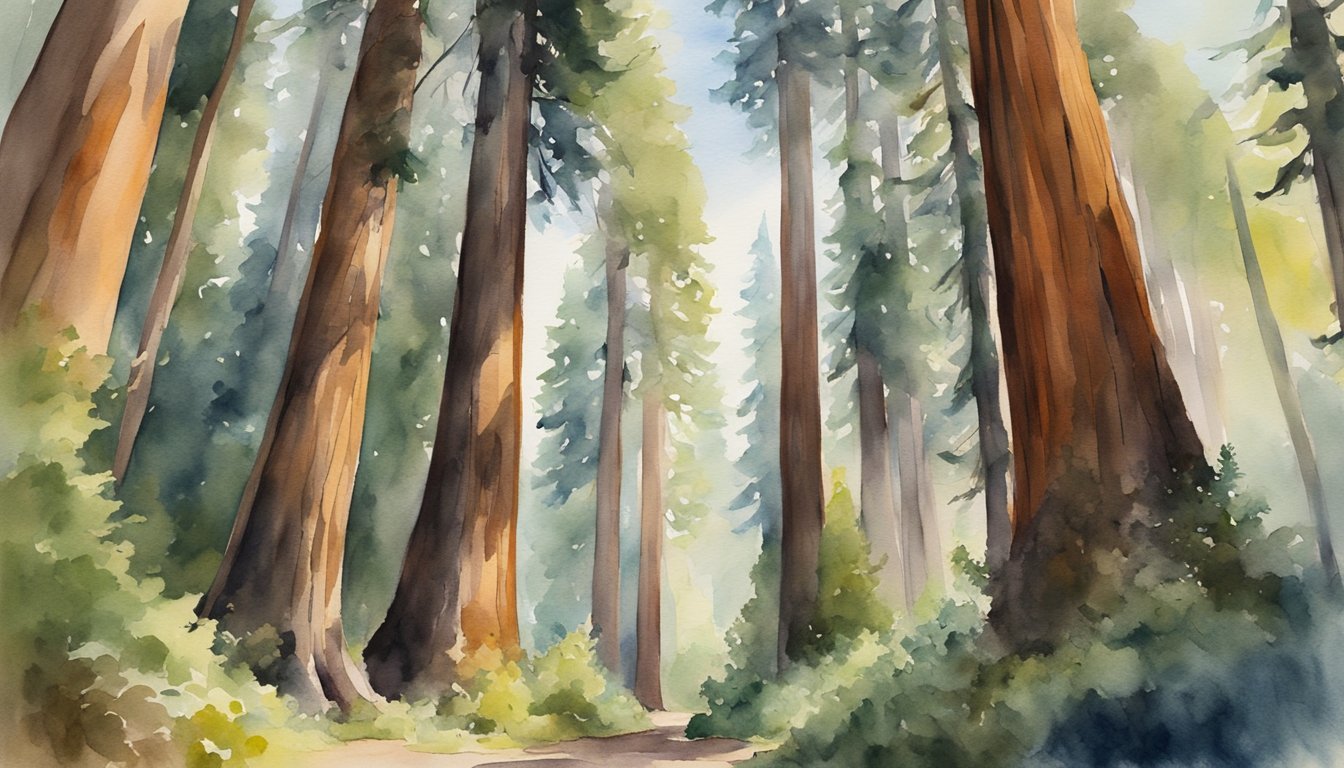Discovering the Giants
Exploring the realm of the tallest trees on earth reveals not only their impressive dimensions but also the specific regions these arboreal giants call home.
Characteristics of the Tallest Trees
The tallest trees, such as the coast redwood, Sequoia sempervirens, have been known to reach staggering heights. For example, Hyperion, a coast redwood located in Redwood National Park, California, was recorded at a towering height of 379.7 feet. These trees also possess remarkable diameters that can stretch to significant widths, with some reaching 30 feet. The giant sequoia, Sequoiadendron giganteum, while not as tall as the coast redwoods, are massive in volume due to their substantial diameter and solid, thick bark.
- Hyperion: 379.7 feet tall
- Helios: 374.3 feet tall
- Icarus: 371.2 feet tall
- Average giant sequoia diameter: up to 30 feet
- Typical bark thickness for giant sequoias: 1 – 2 feet
The structures of these trees are perfectly adapted to support their immense size, with the redwood tree’s deeply entrenched root system maximizing stability. The living tree’s phenomenal growth is attributed to optimal conditions found in its habitat, alongside genetic factors.
Geographical Distribution
Tall trees such as the coast redwoods and giant sequoias are predominantly found in California. Specifically, the coast redwoods thrive within a narrow strip along the Pacific Coast from southern Oregon to central California, with the most impressive specimens located within Redwood National Park. Giant sequoias, on the other hand, are distributed along the western slope of the Sierra Nevada range in California and are famous residents of certain National Parks like Sequoia and Kings Canyon.
The following table outlines the prime regions where these astonishing trees are found:
| Tree Species | Preferred Region | Notable Parks / Forests |
|---|---|---|
| Coast Redwood | Pacific Coast from southern Oregon to central California | Redwood National and State Parks |
| Giant Sequoia | Western slope of the Sierra Nevada in California | Sequoia and Kings Canyon National Parks |
Although the coast redwood and giant sequoia dominate the record books in the United States, other regions also boast tall trees. The tallest known tropical tree, the yellow meranti in Malaysia, and a recently discovered cypress in Tibet represent the incredible diversity and reach of these forest giants globally.
Ecological Significance and Conservation

The tallest trees in the world, such as the coast redwood, play a pivotal role in their ecosystems and are a focus for conservation efforts due to their historical significance and ecological importance.
Importance to Ecosystems
These ancient giants support complex ecosystems both above and below ground. For instance, the coast redwood, which can live for over 2,000 years and reach heights surpassing 350 feet, is foundational to the forest structure. Their canopies provide habitat for a diverse range of wildlife, including numerous bird species, mammals, and insects, while their roots help stabilize the soil and maintain water quality. Trees like the eucalyptus in southeastern Australia and Tasmania, and others like the southern blue gum, are similarly integral to their environments, supporting a variety of life forms.
Protection and Preservation Efforts
Conservation efforts are critical for the protection of these great trees. Organizations and entities like the U.S. National Park Service actively work to preserve habitats in regions like California and Oregon, where many of these trees are found. Parks and reserves are put in place not only to safeguard the existing old-growth forests but also to facilitate the regeneration of these trees for future generations. For example, efforts in regions home to Shorea faguetiana and Picea sitchensis focus on preventing deforestation and promoting sustainable practices. Australia, known for housing giants such as Australia’s tallest tree, the southern blue gum, also implements protection measures to maintain the health and longevity of these ecological marvels.

